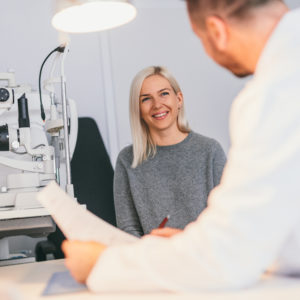It has been an amazing year for optometry scope of practice expansion. As we recently congratulated our colleagues in Massachusetts for being granted the right to prescribe oral medications and to treat glaucoma, New York is only months away from becoming the final state to allow doctors of optometry to prescribe these important medications.
As doctors across the country know, being able to prescribe orals is a fundamental component of practicing and taking care of patients. The last major prescribing milestone for New York doctors was the use of topicals, which passed in 1995. Since then, our colleagues have hoped to some day pass orals legislation. I spoke with Viola Kanevsky, O.D., and Dawn Chivers, O.D., about this legislation and the importance of advocacy.

The answers to the questions below are a combination of responses from the interviewed doctors and the bill, which can be viewed here: NY State Senate Bill S1519 (nysenate.gov)
How do you think the right to prescribe orals will change optometry in New York?
- The biggest changes will be seen in upstate New York, as many patients come from hours away to see their doctor and there are few ophthalmologists available. In some cases, patients have been sent to the ER to obtain the prescription, which creates added expenses, time and opportunity for error.
- In New York City there are many ophthalmologists, so it has been easier for optometrists here to send patients to obtain medications. This legislation will help to streamline this and provide patients easier access to their needed medications.
Do you think the right to prescribe orals will change our relationship with ophthalmology? If so, how?
- No change at all! We know our patients, so we should be able to treat them. It allows us to react faster rather than send them to another doctor and have them overbooked.
Which medications will be included, and how will new doctors be able to prescribe them? Will there be additional continuing education (CE) requirements?
- The bill includes:
- Antibiotics: amoxicillin/clavulanate potassium, cephalexin, azithromycin, sulfamethoxazole/trimethoprim, doxycycline and tetracycline.
- Anti-glaucoma medications: acetazolamide and methazolamide. These two medications can be used for a maximum of one 24-hour prescription and then need to be sent immediately to an ophthalmologist.
- Anti-viral agents: valacyclovir and acyclovir; if the patient has Herpes Zoster Ophthalmicus, the doctor can prescribe a maximum of one 7-day prescription. If the patient has not already been examined by their primary care provider or other appropriate physician, they must be sent within 3 days of diagnosis. This is already standard of care and helps to build relationships.
- The medications included are on a formulary the same way that the topicals bill was designed. This means that if a new medication comes out, an application will have to be made to the Department of Education for us to use it. One goal of the New York State Optometric Association is to eventually expand to non-formulary topical and oral medications.
- New CE requirements:
- 40 hours (at least 24 hours must be live) instruction in pharmacology and drug interaction through clinical cases.
- The requirement for oral therapeutic pharmaceutical agent certification course and exam will not apply to doctors graduating after Jan. 1, 2022, if they have taken and passed their National Board of Examiners in Optometry® exam.
- A minimum of 36 hours in ocular disease and pharmacology is already required every three years for the use of topicals. In addition to this, a minimum of 18 hours related to systemic disease and therapeutic treatment must be completed in the same time period.

How did advocacy push New York to the finish line for the approval of orals? Was it related to COVID-19 and telemedicine?
- Overwhelming support and had nothing to do with COVID or telemedicine!
- Persistence is key, along with the right networking. Assembly members got tired of hearing about it, and once ophthalmologists were on board it was easier to put through.
How can current students and doctors become more involved in advocacy?
- Establish professional relationships with your local legislature and ophthalmologists.
- AOA on Capitol Hill is a great way to practice communicating with your legislators in promoting what is best for your future patients. Asking to shadow or meet with local ophthalmologists is a great way begin networking.
- Attend the Innovation Conference of NY in Corning, New York, at the Radisson Hotel, Sep. 23-26. For SUNY optometry students, there will be a bus from the college to the conference. More information can be found here: Innovation Vision Conference of NY (nysoa.org)

